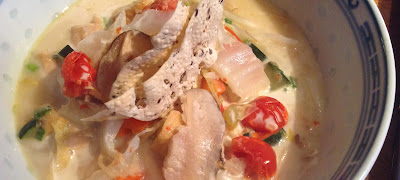Eating pancakes after a day of apple picking in Reeuwijk, Holland, somewhere in the end '90s
I'm happy to say that my mom always made very thin pancakes. So that substance and thickness already made me happier then the pancakes I would get at birthday party's. The biggest problem that I had was the sweetness of it all. I don't have a sweet tooth, so sprinkles, sugars, fruits, syrups, whipped cream, even ice cream didn't do it for me. Afterwards I was always bloated, it felt like I had a dinner-size dessert instead of a meal. But a pancake has two sides, sweet and savory. In my years I came around some savory pancakes, like the ones with cheese or mushrooms or bacon. But somehow Dutchies always cover or drown them in syrup, making it not appealing for me.
But there always was one pancake I liked, a savory one, stuffed with greens and dipped in sauce. I'm talking about Bánh xèo, the Vietnamese pancake. I remembered the first time I saw it. I was six and visiting my family in Los Angeles. I remembered I walked into the backyard, many tables were set and family arrived. The tables were filled with platters of lettuce leaves and herbs. My aunt was slaving away in the outside kitchen, popping out one after an other. Yellow crisp pancakes, stuffed with beansprouts, meat and shrimps. The smell filled my nose and I was sold. The first bite I still remember. How crispy and light the pancakes, the flavors of the meats, herbs and spices, the crunch of the lettuce and herbs, all in a Nouc Mam Cham sauce.
As I said before, a pancake has two sides. It won't be honest to only look at the savory side, so I won't. Or even better I don't have to. Because since a few months I'm making sweet pancakes more often. And these sweet pancakes, I adore and my younger brother with me!
The best thing about both these pancakes is that they're dairy and egg free. I don't really like dairy products, always have a feeling that it is not ok to drink another species's maternal milk. The milk is replaced with plant-based milks. Lighter on the stomach and easier to digest. And in my opinion, cutting down on eggs is never a wrong move. So first up, the savory pancakes. For the sweet ones, stay tuned, or scroll down, up to you.
Bánh xèo vegetarian and non-vegetarian versions
for the pancake batter
200 ml sunfloweroil
400 ml of coconutmilk
400 ml of water
Pinch of salt
Optional: Chopped chives
1 package of bot banh xeo, already mixed riceflour with a pack of tumeric, available in asian markets
In a mixing bowl, put together the bot banh xeo flour mix, the tumeric, the coconutmilk, the oil, water, chives and a pinch of salt. Mix until everything is well combined, cover and set aside for at least an hour.
for the vegetarian filling
300 grams of bean sprouts
200 grams of mushrooms, fresh or dried, soak the dried ones before use, sliced
1 portion of Mai Tofu
1-2 onions
2 tablespoons of vegetarian oystersauce
2 tablespoons of soysauce
Chop the onions, add the soysauce and the mushrooms. Slice up the tofu and marinade in a oystersauce and pepper. Marinade for at least 15 minutes.
for the non-vegetarian filling
300 grams of bean sprouts
300 grams of raw shrips
200 grams of minced meat
1-2 onions
2 tablespoons of nouc mam
2 tablespoons of oystersauce
Peel and clean the shrimp, let them marinade in oystersauce and pepper. Chop the onions and mix them in with the mince. Season with nouc mam and pepper. Marinade for 15-30 minutes in the fridge. Now stiryfry the mince, season well and set aside.
for the essembly
Oil a big skillet on medium-high heat. Pour in a ladle of batter and cover the bottom of the skillet. Cook the pancake for 2 minutes, then cover one half of the pancake with bean sprouts. Let it cook for 3-5 minutes and add the tofu and mushrooms / shrimp and mince. Let it cook for another 2-3 minutes. Fold the uncovered half over the covered half and take out of the skillet.
for the service
1 bunch of fresh mints
1 bunch of fresh cilantro/coriander
1 lettuce, washed leaves of one head
Vegetarian dipping sauce suggestions: Nouc Tuong Gnot (hoisin peanut sauce) or chillisauce
Non-vegetarian dipping sauce suggestions: Nouc Mam Cham (Vietnamese fishsauce)
Serve the pancakes crispy and lukewarm to warm. If you cover them to keep warm, they will lose their crispiness. Or pop them out of the skillet into a preheated oven 80 C/ 175 F until serving. Or pop them back into the skillet to warm and crisp up, just before serving. Serve with the herbs, lettuce and dipping sauce.
------
For my sweet pancakes I always use almondmilk, now a days you can buy it easily in the supermarkets. But it's really easy to make it yourself.
DIY Almondmilk for 1 liter of almondmilk
200 grams of raw almonds
1 liter of water
1 tablespoon of honey, to make it vegan you can use another sweetner
pinch of salt
Optional: cinnamon, cloves, vanilla or soaked dried fruits, for flavoring the milk
Let the almond soak in water overnight. Wash them and put them in a blender. Add the water, salt and honey. I like to add around a teaspoon of cinnamon for taste. Now blits away, put the blender on high for a few minutes. Immidiatly you will see the almonds and water turn into a white liquid. When all the almonds are pulverized, taste and see if it needs more taste. Pour the mixture in a deep bowl by pouring through a cheesecloth (or the feet of an unused thin tight). Squize out all the milk, in the cloth you end up with a wet but lovely almond flour. In your bowl, a great almondmilk.
Mai -almost vegan- pancakes
2 teaspoons of baking powder
1 teaspoon of ground cinnamon
Pinch of salt
1-2 cups of almond milk
2 tablespoons of honey
2 cups of whole wheat flour or spelled flour, or mix the flours, or use some almondflour from making the almond milk.
In a large bowl, whisk together flour, baking powder, cinnamon and salt. In a separate bowl, whisk together the almond milk and honey until blended. Pour the milk mixture in the flour mixture and stir until evenly mixed. Set batter aside to rest for 10 minutes, the batter will thicken up.
Oil a nonstick skillet and heat on medium heat until hot. Ladle about 1-2 tablespoons of batter into the skillet and cook about 2 minutes or until bottoms are golden. Flip and cook 1-2 minutes longer, until pancakes are cooked through.
I always make a large batch of these pancakes. I let them cool down, put them in a ziptop bag and pop them in the freezer. So anytime you want a pancake, you just defrost, reheat and you have a great breakfast. A start to a fancy brunch or lunch or just as a little snack. Just drizzle some honey on top and you are good to go, the healthiest pancakes in the world. Or go a little less healthy and dress them up with icing sugar and some fresh fruits. Or going fancy all the way, with ice cream or whipped cream.
------
In my opinion these two recipes shows the best sides of the pancake. A great Asian flavorburst savory pancake and a lovely sweet and healthy pancake! So if you're thinking about throwing a party, don't forget Holland's favorite party meal, let everybody enjoy a new side of the pancake!


































